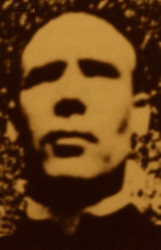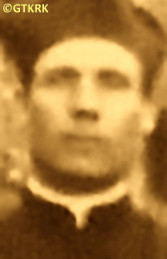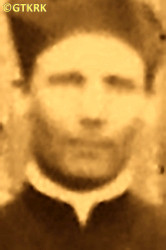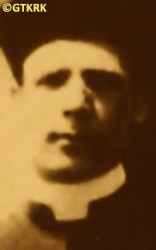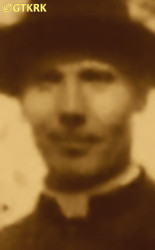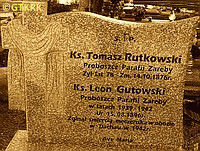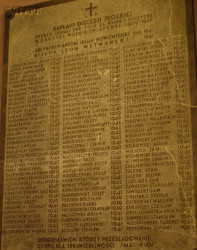Roman Catholic
St Sigismund parish
05-507 Słomczyn
85 Wiślana Str.
Konstancin deanery
Warsaw archdiocese, Poland
full list:
displayClick to display full list

searchClick to search full list by categories
wyświetlKliknij by wyświetlić pełną listę po polsku

szukajKliknij by przeszukać listę wg kategorii po polsku

Martyrology of the clergy — Poland
XX century (1914 – 1989)
personal data
surname
GUTOWSKI
forename(s)
Leo (pl. Leon)
function
diocesan priest
creed
Latin (Roman Catholic) Church RCmore on
en.wikipedia.org
[access: 2014.09.21]
diocese / province
Płock diocesemore on
en.wikipedia.org
[access: 2013.05.19]
Superior diocese (US‐WI)more on
en.wikipedia.org
[access: 2024.03.02]
date and place
of death
10.08.1942

TA HartheimSchloss Hartheim „euthanasia” center
today: Alkoven, Eferding dist., Salzburg state, Austria
more on
en.wikipedia.org
[access: 2022.07.18]
alt. dates and places
of death
25.09.1942 (KL Dachau „death certificate” date)
details of death
After German and Russian invasion of Poland in 09.1939 and start of the World War II, after start of German occupation, evicted by the Germans from his rectory.
Moved to the house of one of his parishioners.
Arrested by the Germans on 17.06.1941.
Jailed in Przasnysz.
Next moved to KL Soldau concentration camp.
On 29.08.1941 transported to KL Dachau concentration camp.
Finally — totally exhausted — transferred in a so‐called Germ. „Invalidentransport” (Eng. „Invalids' transport”) to TA Hartheim Euthanasia Center and murdered in a gas chamber.
According to the death certificate, prepared in KL Dachau, the „honest” otherwise German „medical doctors” and formalists — and at the same time, unrivaled fairy tale spinners — noted that the cause of death was Germ. „Versagen von Herz und Kreislauf, bei Darmkatarrch” (Eng. „Heart and circulatory failure, with intestinal catarrh”).
prisoner camp's numbers
27112Click to display source page (KL DachauClick to display the description)
cause of death
extermination: gassing in a gas chamber
perpetrators
Germans
sites and events
TA HartheimClick to display the description, «Aktion T4»Click to display the description, KL DachauClick to display the description, KL SoldauClick to display the description, Ribbentrop‐MolotovClick to display the description, Pius XI's encyclicalsClick to display the description
date and place
of birth
31.08.1896Birth certification on:
photos.szukajwarchiwach.gov.pl
[access: 2025.08.19]

Sierpctoday: Sierpc urban gm., Sierpc pov., Masovia voiv., Poland
more on
en.wikipedia.org
[access: 2021.12.18]
parents
GUTOWSKI Adam
🞲 ?, ? — 🕆 ?, ?

PEJCZ Elisabeth
🞲 ?, ? — 🕆 ?, ?
baptism
06.09.1896Birth certification on:
photos.szukajwarchiwach.gov.pl
[access: 2025.08.19]

Sierpctoday: Sierpc urban gm., Sierpc pov., Masovia voiv., Poland
more on
en.wikipedia.org
[access: 2021.12.18]
St Vitus, St Modestus and St Crescentia RC church
presbyter (holy orders)
ordination
03.05.1927

positions held
1939 – 1941
parish priest — Zarębytoday: Chorzele gm., Przasnysz pov., Masovia voiv., Poland
more on
en.wikipedia.org
[access: 2022.08.05] ⋄ St Lawrence RC parish
1937 – 1939
vicar — Płoniawytoday: Płoniawy‐Bramura, Płoniawy‐Bramura gm., Maków Mazowiecki pov., Masovia voiv., Poland
more on
en.wikipedia.org
[access: 2021.12.18] ⋄ Transfiguration of the Lord RC church ⋄ St Stanislav the Bishop and Martyr RC parish ⋄ Maków Mazowieckitoday: Maków Mazowiecki urban gm., Maków Mazowiecki pov., Masovia voiv., Poland
more on
en.wikipedia.org
[access: 2021.08.06] RC deanery
1936 – 1937
vicar — Dobrzyń nad Wisłątoday: Dobrzyń nad Wisłą gm., Lipno pov., Kuyavia‐Pomerania voiv., Poland
more on
en.wikipedia.org
[access: 2021.12.18] ⋄ Assumption of the Blessed Virgin Mary RC parish ⋄ Dobrzyń nad Wisłątoday: Dobrzyń nad Wisłą gm., Lipno pov., Kuyavia‐Pomerania voiv., Poland
more on
en.wikipedia.org
[access: 2021.12.18] RC deanery
1936
administrator — Iron Rivertoday: Bayfield Cou., Wisconsin US‐WI state, United States of America
more on
en.wikipedia.org
[access: 2021.12.18] ⋄ St Michael RC parish — also: chaplain at St Peter and St Paul in Moquah; St Florian's in Ino; St Peter's in Dauby; and St Anne's in Sanborn missions in Wisconsin US
1929 – 1936
parish priest — Saxontoday: Iron Cou., Wisconsin US‐WI state, United States of America
more on
en.wikipedia.org
[access: 2021.12.18] ⋄ St Anne RC parish
1927 – 1929
chaplain — Rhinelandertoday: Oneida Cou., Wisconsin US‐WI state, United States of America
more on
en.wikipedia.org
[access: 2021.12.18] ⋄ Blessed Virgin Mary Hospital
1923 – 1927
student — Saint Paultoday: Ramsey Cou., Minnesota US‐MN state, United States of America
more on
en.wikipedia.org
[access: 2021.12.18] ⋄ philosophy and theology, St Paul Theological Seminary
till 1923
student — Montrealtoday: Montreal reg., Quebec prov., Canada — philosophy and French
from 1917
student — Mount Calvarytoday: Fond du Lac Cou., Wisconsin US‐WI state, United States of America
more on
en.wikipedia.org
[access: 2021.12.18] ⋄ St Lawrence High School Seminary
others related
in death
ABTClick to display biography Steven, AKSMANClick to display biography Julius Felician, ANDRZEJEWSKIClick to display biography Casimir, BĄKClick to display biography John Baptist, BIELOWSKIClick to display biography Joseph, CEPIELClick to display biography Charles, CHABERKOWSKIClick to display biography Steven, CHYCZEWSKIClick to display biography Joseph, CISZAKClick to display biography Boleslav, CZAPCZYKClick to display biography Henry, DEMBOWSKIClick to display biography Casimir Marian Anthony, DETKENSClick to display biography Edward, DRAPIEWSKIClick to display biography Theodore Hillary, DRZEWIECKIClick to display biography Francis, DYJAClick to display biography Edward, DZIENISZClick to display biography Leo, FALKOWSKIClick to display biography Theophilus, GABRYELSKIClick to display biography Thaddeus Narcissus, GRABOWSKIClick to display biography Sigismund Steven, GRZESITOWSKIClick to display biography Stanislav, GRZYMAŁAClick to display biography Edward, GZELClick to display biography Eugene Henry, HERMAŃCZYKClick to display biography Oscar Louis Ignatius, JARANOWSKIClick to display biography Boleslav Ignatius, KAZIMIEROWICZClick to display biography Henry Maximilian, KLINClick to display biography Conrad Anastasius, KONSTANTYNOWICZClick to display biography Stanislav Peter, KORCZAKClick to display biography Valentine, KOSTRZEWAClick to display biography Nicholas, KOTELAClick to display biography Joseph, KOWALSKIClick to display biography Sigismund Marian, KOZIKClick to display biography Valentine (Fr Cherubin), KRĘCICKIClick to display biography Boleslav, KRZAKClick to display biography William, KURKOWSKIClick to display biography Leo Paul, LASKOWSKIClick to display biography Henry Eugene, MACIEJEWSKIClick to display biography Leo, MAKOWSKIClick to display biography Alexander, MĄDRYClick to display biography John, MICHNIEWSKIClick to display biography Stanislav Thomas, MOLSKIClick to display biography Joseph
sites and events
descriptions
TA Hartheim: From 05.1940, in the Germ. Tötungsanstalt (Eng. Killing/Euthanasia Center) TA Hartheim, at the Schloss Hartheim castle in Alkoven in Upper Austria, belonging to KL Mauthausen‐Gusen complex of concentration camps, as part of «Aktion T4» program, the Germans murdered victims — people mentally retarded and disabled — in gas chambers with carbon monoxide. Till 24.08.1941 and the formal end of the «Aktion T4» program, c. 18,000 people were murdered in TA Hartheim. In 04.1941 the program was extended to include concentration camp prisoners. Most, if not all, of the murdered clergy from the KL Dachau concentration camp were taken to TA Hartheim in the so‐called Germ. „Invalidentransport” (Eng. „transport of invalids”), prisoners who were sick and, according to the Germans, „unable to work” (initially under the pretext of transfer to a better camp) — after the formal end of «Aktion T4» as part of the program codenamed «Aktion 14 f 13». It is estimated that at this stage — until 11.12.1944 — c. 12,000 prisoners were gassed at TA Hartheim.
Note: The dates of death of victims murdered in Schloss Hartheim indicated in the „White Book” are the dates of deportations from the last concentration camp the victims where held in. The real dates of death are unknown — apart from c. 49 priests whose names were included in the niem. „Invalidentransports”, but who did not arrive at TA Hartheim. Prob. perished on the day of transport, somewhere between KL Dachau and Munich, and their bodies were thrown out of the transport and cremated in Munich. The investigation conducted by Polish Institute of National Remembrance IPN concluded, that the other victims were murdered immediately upon arrival in Schloss Hartheim, bodies cremated and the ashes spread over local fields and into Danube river. In order to hide details of the genocide Germans falsified both dates of death (for instance those entered into KL Dachau concentration camp books, which are presented in „White Book” as alternative dates of death) and their causes. (more on: ipn.gov.plClick to attempt to display webpage
[access: 2019.05.30], en.wikipedia.orgClick to attempt to display webpage
[access: 2019.05.30])
«Aktion T4»: German state euthanasia program, systematic murder of people mentally retarded, chronically, mentally and neurologically ill — „elimination of live not worth living” (Germ. „Vernichtung von lebensunwertem Leben”). At a peak, in 1940‐1941, c. 70,000 people were murdered, including patients of psychiatric hospitals in German occupied Poland — German formalists noted then that, among others, „performing disinfection [i.e. gassing] of 70,273 people with a life expectancy of up to 10 years saved food in the amount of 141,775,573.80 Deutschmark”. From 04.1941 also mentally ill and „disabled” (i.e. unable to work) prisoners held in German concentration camps were included in the program — denoted then as «Aktion 14 f 13». C. 20,000 inmates were then murdered, including Polish Catholic priests held in KL Dachau concentration camp, who were murdered in Hartheim gas chambers. The other „regional extension” of «Aktion T4» was «Aktion Brandt» program during which Germans murdered chronically ill patients in order to make space for wounded soldiers. It is estimated that at least 30,000 were murdered in this program. (more on: en.wikipedia.orgClick to attempt to display webpage
[access: 2014.10.31])
KL Dachau: KL Dachau in German Bavaria, set up in 1933, became the main German Germ. Konzentrationslager (Eng. concentration camp) KL for Catholic priests and religious during World War II: On c. 09.11.1940, Reichsführer‐SS Heinrich Himmler, head of the SS, Gestapo and German police, as a result of the Vatican's intervention, decided to transfer all clergymen detained in various concentration camps to KL Dachau camp. The first major transports took place on 08.12.1940. In KL Dachau Germans held approx. 3,000 priests, including 1,800 Poles. The priests were forced to slave labor in the Germ. „Die Plantage” — the largest herb garden in Europe, managed by the genocidal SS, consisting of many greenhouses, laboratory buildings and arable land, where experiments with new natural medicines were conducted — for many hours, without breaks, without protective clothing, no food. They slaved in construction, e.g. of camp's crematorium. In the barracks ruled hunger, freezing cold in the winter and suffocating heat during the summer, especially acute in 1941‐1942. Prisoners suffered from bouts of illnesses, including tuberculosis. Many were victims of murderous „medical experiments” — in 11.1942 c. 20 were given phlegmon injections; in 07.1942 to 05.1944 c. 120 were used by for malaria experiments. More than 750 Polish clerics where murdered by the Germans, some brought to TA Hartheim euthanasia centre set up in Schloss Hartheim in Austria and murdered in gas chambers. At its peak KL Dachau concentration camps’ system had nearly 100 slave labour sub‐camps located throughout southern Germany and Austria. There were c. 32,000 documented deaths at the camp, and thousands perished without a trace. C. 10,000 of the 30,000 inmates were found sick at the time of liberation, on 29.04.1945, by the USA troops… (more on: www.kz-gedenkstaette-dachau.deClick to attempt to display webpage
[access: 2013.08.10], en.wikipedia.orgClick to attempt to display webpage
[access: 2016.05.30])
KL Soldau: German Germ. Konzentrationslager (Eng. concentration camp) KL Soldau (in modern Działdowo city) — since the pre‐war Polish Działdowo county was incorporated into Germ. Regierungsbezirk Allenstein (Eng. Olsztyn regency) the camp was located in occupied territories where general German law was in force, i.e. in Germany proper — was founded in 09.1939, when in former barracks of 32nd Infantry Regiment of Polish Army Germans set up a temporary camp for POW captured during September 1939 campaign. In autumn 1939 was also used as police jail. In 1939‐1940 changed into Germ. Durchgangslager für polnische Zivilgefangene (Eng. Transit Camp for Polish Civilians), prior to transport to other concentration camps. In reality it was used then as a place of extermination of Polish intelligentsia within Germ. «Intelligenzaktion» genocidal program and extermination of sick and disabled within «Aktion T4» program. Next in 05.1940 the camp was changed again into Germ. Arbeitserziehungslager (Eng. Work Education Camp), and finally into penal comp for criminal and political prisoners, most of whom were sentenced to death. In 1939‐1941 Germans imprisoned, maltreated and tortured in KL Soldau hundreds of Polish priests and religious. Approx. 80 priests, religious and nuns perished. They were murdered in the camp itself, by a shot into a head, or in places of mass executions in nearby forests — Białuty forest, Malinowo forets, Komorniki. Dates and precise locations of these murders remain unknown. Altogether in KL Soldau approx. 15,000 prisoners were murdered, including thousands victims — patients of psychiatric institutions (within «Aktion T4» plan). (more on: mazowsze.hist.plClick to attempt to display webpage
[access: 2013.08.17], en.wikipedia.orgClick to attempt to display webpage
[access: 2018.09.02])
Ribbentrop‐Molotov: Genocidal Russian‐German alliance pact between Russian leader Joseph Stalin and German leader Adolf Hitler signed on 23.08.1939 in Moscow by respective foreign ministers, Mr. Vyacheslav Molotov for Russia and Joachim von Ribbentrop for Germany. The pact sanctioned and was the direct cause of joint Russian and German invasion of Poland and the outbreak of the World War II in 09.1939. In a political sense, the pact was an attempt to restore the status quo ante before 1914, with one exception, namely the „commercial” exchange of the so‐called „Kingdom of Poland”, which in 1914 was part of the Russian Empire, fore Eastern Galicia (today's western Ukraine), in 1914 belonging to the Austro‐Hungarian Empire. Galicia, including Lviv, was to be taken over by the Russians, the „Kingdom of Poland” — under the name of the General Governorate — Germany. The resultant „war was one of the greatest calamities and dramas of humanity in history, for two atheistic and anti‐Christian ideologies — national and international socialism — rejected God and His fifth Decalogue commandment: Thou shall not kill!” (Abp Stanislav Gądecki, 01.09.2019). The decisions taken — backed up by the betrayal of the formal allies of Poland, France and Germany, which on 12.09.1939, at a joint conference in Abbeville, decided not to provide aid to attacked Poland and not to take military action against Germany (a clear breach of treaty obligations with Poland) — were on 28.09.1939 slightly altered and made more precise when a treaty on „German‐Russian boundaries and friendship” was agreed by the same murderous signatories. One of its findings was establishment of spheres of influence in Central and Eastern Europe and in consequence IV partition of Poland. In one of its secret annexes agreed, that: „the Signatories will not tolerate on its respective territories any Polish propaganda that affects the territory of the other Side. On their respective territories they will suppress all such propaganda and inform each other of the measures taken to accomplish it”. The agreements resulted in a series of meeting between two genocidal organization representing both sides — German Gestapo and Russian NKVD when coordination of efforts to exterminate Polish intelligentsia and Polish leading classes (in Germany called «Intelligenzaktion», in Russia took the form of Katyń massacres) where discussed. Resulted in deaths of hundreds of thousands of Polish intelligentsia, including thousands of priests presented here, and tens of millions of ordinary people,. The results of this Russian‐German pact lasted till 1989 and are still in evidence even today. (more on: en.wikipedia.orgClick to attempt to display webpage
[access: 2015.09.30])
Pius XI's encyclicals: Facing the creation of two totalitarian systems in Europe, which seemed to compete with each other, though there were more similarities than contradictions between them, Pope Pius XI issued in 03.1937 (within 5 days) two encyclicals. In the „Mit brennender Sorge” (Eng. „With Burning Concern”) published on 14.03.1938, condemned the national socialism prevailing in Germany. The Pope wrote: „Whoever, following the old Germanic‐pre‐Christian beliefs, puts various impersonal fate in the place of a personal God, denies the wisdom of God and Providence […], whoever exalts earthly values: race or nation, or state, or state system, representatives of state power or other fundamental values of human society, […] and makes them the highest standard of all values, including religious ones, and idolizes them, this one […] is far from true faith in God and from a worldview corresponding to such faith”. On 19.03.1937, published „Divini Redemptoris” (Eng. „Divine Redeemer”), in which criticized Russian communism, dialectical materialism and the class struggle theory. The Pope wrote: „Communism deprives man of freedom, and therefore the spiritual basis of all life norms. It deprives the human person of all his dignity and any moral support with which he could resist the onslaught of blind passions […] This is the new gospel that Bolshevik and godless communism preaches as a message of salvation and redemption of humanity”… Pius XI demanded that the established human law be subjected to the natural law of God , recommended the implementation of the ideal of a Christian state and society, and called on Catholics to resist. Two years later, National Socialist Germany and Communist Russia came together and started World War II. (more on: www.vatican.vaClick to attempt to display webpage
[access: 2023.05.28], www.vatican.vaClick to attempt to display webpage
[access: 2023.05.28])
sources
personal:
www.kuria.lomza.plClick to attempt to display webpage
[access: 2012.11.23], superiorcatholicherald.orgClick to attempt to display webpage
[access: 2021.12.18], photos.szukajwarchiwach.gov.plClick to attempt to display webpage
[access: 2025.08.19], miejscowosc-zareby.eu.interia.plClick to attempt to display webpage
[access: 2013.10.05]
bibliographical:
„Płock diocese clergy martyrology during II World War 1939‐1945”, Fr Nicholas Marian Grzybowski, Włocławek–Płock 2002
„Martyrology of the Polish Roman Catholic clergy under nazi occupation in 1939‐1945”, Victor Jacewicz, John Woś, vol. I‐V, Warsaw Theological Academy, 1977‐1981
„International Tracing Service (ITS), Bad Arolsen, GermanyClick to display source page”, Arolsen Archives
original images:
mojezareby.blogspot.comClick to attempt to display webpage
[access: 2021.12.18], mojezareby.blogspot.comClick to attempt to display webpage
[access: 2021.12.18], mojezareby.blogspot.comClick to attempt to display webpage
[access: 2019.04.16], mojezareby.blogspot.comClick to attempt to display webpage
[access: 2019.04.16], mojezareby.blogspot.comClick to attempt to display webpage
[access: 2021.12.18]
LETTER to CUSTODIAN/ADMINISTRATOR
If you have an Email client on your communicator/computer — such as Mozilla Thunderbird, Windows Mail or Microsoft Outlook, described at WikipediaPatrz:
en.wikipedia.org, among others — try the link below, please:
LETTER to CUSTODIAN/ADMINISTRATORClick and try to call your own Email client
If however you do not run such a client or the above link is not active please send an email to the Custodian/Administrator using your account — in your customary email/correspondence engine — at the following address:

giving the following as the subject:
MARTYROLOGY: GUTOWSKI Leo
To return to the biography press below:
 Click to return to biography
Click to return to biography








